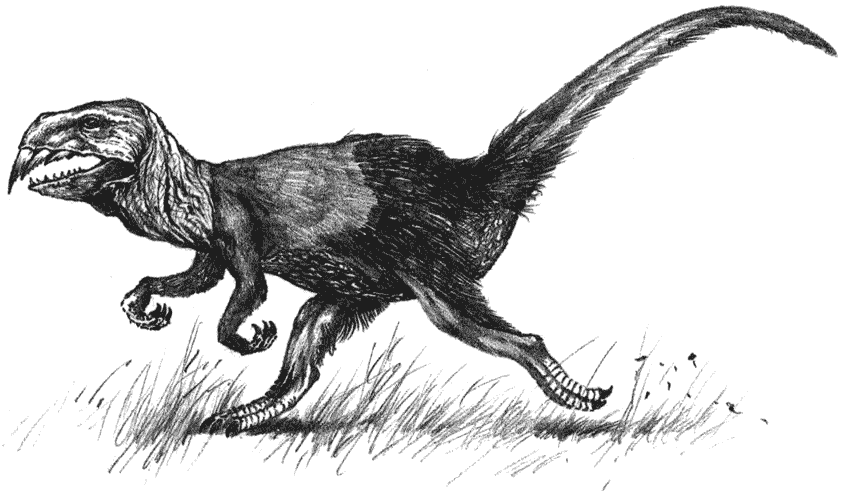| Main | Site library | Forum | Guestbook |
Dougal Dixon
The New Dinosaurs
An alternative evolution

THE NEW AN ALTERNATIVE EVOLUTION DOUGAL DIXON
FOREWORD BY DESMOND MORRIS
Salem House Publishers |
Text copyright © Dougal Dixon 1988
This edition copyright © Eddison/Sadd Editions 1988
All rights reserved. No part of this work may be reproduced or utilized
in any form, or by any means, electronic or mechanical including
photocopying, recording or by any information storage and retrieval
system, without the prior written agreement of the publisher.
First published in the United States by Salem House Publishers, 1988,
462 Boston Street, Topsfield, MA 01983.
Library of Congress Cataloguing-in-Publication Data
Dixon, Dougal.
The new dinosaurs.
1. Dinosaurs. I. Title.
QE862.D5D55 1988 567.9'1 88-1994
ISBN 0-88162-301-6
AN EDDISON-SADD EDITION
Edited, designed and produced by
Eddison/Sadd Editions Limited
St Chad’s Court, 146B King’s Cross Road, London WC1X 9DH
Phototypeset by Bookworm Typesetting, Manchester, England
Origination by Columbia Offset, Singapore
Printing, binding and manufacture in Spain by Graficas Estella, S.A.
CONTENTS
FOREWORD
THE GREAT EXTINCTION 6
WHAT IS A DINOSAUR? 10
THE NEW TREE OF LIFE 12
PALAEOGEOGRAPHY 16
ZOOGEOGRAPHY 18
THE HABITATS 20
THE NEW DINOSAURS 29
THE ETHIOPIAN REALM 30
THE PALAEARCTIC REALM 42
THE NEARCTIC REALM 54
THE NEOTROPICAL REALM 66
THE ORIENTAL REALM 78
THE AUSTRALASIAN REALM 88
THE OCEANS 100
CONCLUSION 108
AFTERWORD 109
GLOSSARY 113
FURTHER READING 115
INDEX 116
ACKNOWLEDGEMENTS 120
FOR LINDSAY
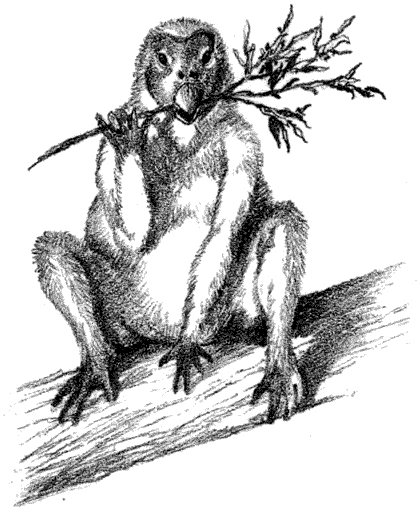
For the many who enjoyed, as I did, Dougal Dixon’s first book of imaginary
animals – AFTER MAN, A ZOOLOGY OF THE FUTURE – his new volume will provide
further delights. There is the same technical skill, the same brilliant inventiveness
and, without question, the same joyous celebration of the evolutionary process.
As before, the author has never allowed his imaginative leaps to go beyond
the bounds of biological possibility, and it is this self-discipline that
puts his fictitious fauna streets ahead of anything found elsewhere, in either
science fiction writing or in Hollywood films about ‘lost worlds’ or primeval
struggles.
As a zoologist I nearly always find myself disappointed by other people’s
imaginary animals. The monsters they concoct are usually boringly obvious
or totally improbable. But Dougal Dixon knows exactly what he is doing and
gives such conviction to his creatures that it is sometimes hard to convince
oneself that, somewhere, at some time or other, they have not really existed
- and perhaps even exist today, if only we could be lucky enough to discover
them.
With each turn of the page I am excited to find what new form will greet
my eyes, and I am rarely disappointed. The only let-down is the realization
that, despite their amazingly detailed representations, we will never be
able to come face to face with a living Dougaloid. But no matter, they will
always be here between the covers of his books, for us to enjoy whenever
we feel the need to release ourselves from the tyranny of the world as it
is, and enjoy how it might have been.
By making a single, simple alteration in the earth’s prehistory, namely the
absence of the catastrophe that wiped out the great dinosaurs, Dixon has
set us off on a new evolutionary voyage – a truly creative endeavour and
one which I have relished from start to finish. What he has done – with both
AFTER MAN and THE NEW DINOSAURS is so exciting that I feel – it deserves
a special name of its own: Alternative Zoology. And I for one cannot wait
for the next volume to appear, when, who knows, the author may take us off
to another planet altogether, where a parallel evolutionary process has taken
place, guided by the special environmental conditions that exist there. In
Dixon’s safe hands, what a wonderful safari that could be.

THE THEORIES
The dinosaurs were some of the most magnificent creatures
that ever lived. They evolved in the late Triassic period, about 220 million
years ago, and
from humble crocodile-like origins, became the most varied and abundant
animals
on Earth.
Nimble, darting, brightly coloured meat-eaters chased lizards through the
ferny undergrowth. Big meat-eaters strode dragon-like through the forests
hunting slow-moving prey. Huge long-necked plant-eaters, veritable mountains
of flesh, roamed open plains and woodlands in family groups, browsing from
the tops of the trees, and keeping wary eyes open for the predacious hunters.
Small, fleet-footed plant-eaters sprinted on their long hind legs from
one patch of vegetation to another, snatching at leaves and shoots, and
quickly
ducking away when danger threatened. Lumbering armoured plant-eaters, safe
behind their flamboyant and colourful plates and horns, chomped and chewed
the prolific vegetation in the warm and equable climates of the long, tranquil
Jurassic and Cretaceous periods.
For over 180 million years they were the most successful life form on the
planet.
And then they all disappeared.
The Great Extinction, as their disappearance has come to be known, befell
the dinosaurs at the end of the Cretaceous period, about 65 million years
ago. At this time not just the dinosaurs but about 75 per cent of all living
creatures were wiped from the face of the Earth.
The rocks supply the evidence. The strata that date from before this time
contain the fossils of the kinds of animals that had been present for 150
million years previously. Rocks that formed from continental deposits,
such as shales and mudstones from river sediments, and sandstones from
deserts,
contain the remains of dinosaurs and flying pterosaurs. Rocks that formed
in the sea, such as limestones and chalk, contain the fossils of sea reptiles
like plesiosaurs and mosasaurs, the ubiquitous pterosaurs, and invertebrates
like the tentacled shellfish, the ammonites.
Then there is a break in the strata and the rocks immediately above exhibit
a different picture of life on Earth. No dinosaurs or pterosaurs are evident
here. Nor are there fossils of marine reptiles or ammonites. Something
had happened to change things completely. This break gives a useful boundary
for geological dating. The time before the break is called the Cretaceous
period of the Mesozoic era. Creta is the Greek word for chalk and the period
is named for the deposits of chalk that were laid down in the sea at this
time. The time immediately after the break is called the Palaeocene epoch
of the Tertiary period. Palaeocene means the ancient epoch of modern life
and the ‘modern life’ referred to here means, basically, the mammals.
Up to this point the mammals had been very small and insignificant, scuttling
mouse-like among the feet of the dinosaurs and scrambling squirrel-like up
trees beyond their reach. Throughout the 150 million-year Age of Reptiles they
did not amount to much at all. Then, as the dinosaurs and the other great reptiles
disappeared, they came into their own. It is the way of evolution that, once
a particular animal dies out, something else will soon develop to take its
place. Wherever there is a food source that is not exploited, an animal will
evolve to exploit it. With the total disappearance of the great reptiles, there
was a complete replacement by new creatures, and these new creatures were the
mammals. Pigs and elephants evolved to take the place of the herbivorous dinosaurs.
Strange wolf-like mammals called creodonts evolved to prey on them, taking
the place of the carnivorous dinosaurs. In the absence of pterosaurs, the bats
evolved. In the seas, whales and seals developed to take the place of the plesiosaurs
and mosasaurs. The Age of Reptiles had clearly given way to the Age of Mammals.
How had this great change come about? It was certainly nothing to do with the
mammals becoming stronger and more successful and hence ousting the reptiles.
As we have seen, it was the other way round. Something else had killed off
the creatures that had been established for 150 million years. The cause may
have been sudden, or it may have been gradual. The geological record is deceptive
when it comes to calculating time. A million years is a mere eye-blink and
may be represented by a bed of rock a few centimetres thick — or even no rock
at all.
It could have been a bang
It may have come as a bolt from the blue. For as long as
scientists have been puzzling over the question of the extinction of the
great reptiles,
there have been theories suggesting that some extraterrestrial cataclysm
was responsible. The notion of a nearby supernova was once popular. According
to this theory there had been an explosion of a star a few light years
from this planet. The Earth was bathed in lethal doses of ultra-violet
radiation, and a few years later the dust from the explosion passed through
our solar system dimming the warmth of the sun. All this was too much
for the reptiles, who had become used to a period of settled conditions,
and
they died out. This particular theory is no longer widely held.
A more spectacular and more recent theory is that of a meteorite impact.
According to this idea a meteorite about 10 kilometres (6 m) in diameter
may have struck the Earth about 65 million years ago. This caused a great
explosion sending clouds of dust, sixty times the mass of the meteorite
itself, up into the atmosphere. These clouds produced a perpetual overcast
blotting out the sun for months, or even years. Temperatures fell worldwide,
and with no sun the plants died back. Added to this, the heat of the
impact produced chemical changes in the local atmosphere, generating
nitrogen oxides that spread over large areas as acid rain. The plant-eating
dinosaurs perished without food, and the meat-eaters also died out when
their prey disappeared. In the oceans there was a similar collapse in
the food chain, with planktonic organisms dying, thus killing off the
creatures that fed on them. Once the skies cleared the plants grew again,
since most plants can remain dormant for a short period, but all the
big animals were gone. Only small creatures like the contemporary mammals
were able to avoid the chaos, probably by digging underground and hibernating.
Alternatively, the impact may have been caused by a comet rather than
a meteorite. Since a comet consists of much lighter material than a meteorite,
it would have taken a very large comet, or indeed a swarm of comets,
to produce the damage needed to cause the extinctions. There is a theory
that our sun has another star as a near neighbour, and every 26 million
years or so the relative positions of these two bodies generates a large
number of comets that could bombard the planets of the solar system including
the Earth. The timing of the other mass extinctions in the fossil record
– for the end of the Cretaceous was not a unique event – suggests that
there was a regular factor such as this involved.
But if these theories are to be believed, where is the crater that the
impact of a meteorite or a comet would have made? Had the extraterrestrial
body landed on a continent it would certainly have left some mark that
would have been visible today. However, since two-thirds of the Earth’s
surface is covered by sea, there is a strong likelihood that the meteorite
or comet would have landed in an ocean area and the site has remained
undiscovered, or has been swallowed up by the natural processes of plate
tectonics, or the movement of the outer layers of the Earth’s structure.
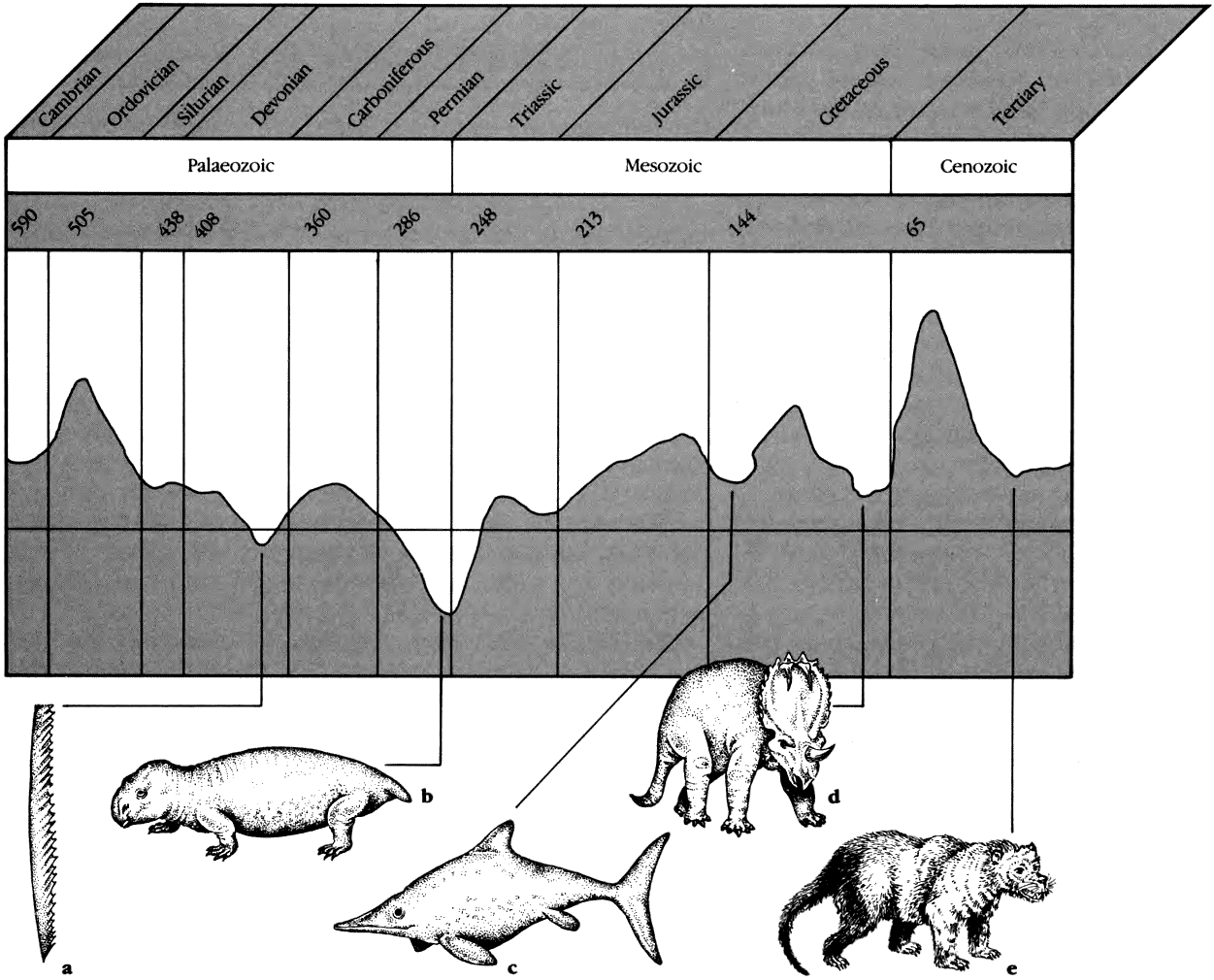
Periodic extinctions
The
extinction of much of the animal life of the world at the end of the Cretaceous
period was not an isolated event. Mass extinctions have occurred
throughout time. In a mass extinction in Devonian times, the graptolites
(Monograptus, a) — small colonial creatures that had drifted in the oceans
since the Cambrian - died out along with many other sea animals. At the end
of the Permian, huge land-living amphibians and most of the mammal-like reptiles
(Dicynodon, b) died out. The early Cretaceous saw the extinction of ichthyosaurs
(Ophthalmosaurus, c) among other beasts. The late Cretaceous event was important
from the point of view of large land-living animals (Triceratops, d),
but a further extinction in the Tertiary removed many primitive mammals,
like
the meat-eating creodonts (Sarkastodon, e), and replaced them with more modern
types.
An impact in the sea would introduce another lethal factor. The huge clouds
of steam blasted into the atmosphere would cast an insulating blanket around
the Earth, retaining its heat. The temperatures at the Earth’s surface would
therefore rise, like in a greenhouse, upsetting the delicate balance of climate
that had existed for so long. A temperature rise of 10 degrees Celsius (18°F)
– perfectly feasible under the circumstances – would have been enough to
cause the biological disaster.
Evidence for an extraterrestrial assault of some kind comes from a layer
of clay found at about fifty places on the Earth’s surface where the rocks
grade upwards from Cretaceous to Palaeocene deposits. This layer is rich
in the metal iridium, rarely found at the Earth’s surface. There is about
twenty times as much iridium in this layer than would normally be expected.
Iridium is very dense and so the greatest concentrations in the Earth lie
at great depths below the crust. Iridium is, however, quite common in meteorites
and other interplanetary bodies. This widespread deposit appearing at the
end of the Cretaceous period may well have come from the dusty debris of
a gigantic meteorite impact.
Further chemical analysis of these rocks gives added support to the theory.
There is little calcium carbonate – the chemical from which shells are made
– in this layer of clay. This suggests that shelled creatures were not very
abundant in the water at that time, possibly devastated by whatever happened
above or, alternatively, the increased acidity formed by the acid rain broke
down the calcium carbonate of their shells after death.
The calcium carbonate that does exist in this layer can be analysed for its
isotope makeup. Atoms of a particular element may exist in different forms,
or isotopes, and an element in a particular substance will have different
ratios of isotopes depending on the conditions under which the substance
formed. The isotopes of the oxygen and carbon in the calcium carbonate of
this clay layer suggest that there was a sudden period of cooling by about
8 degrees Celsius (14°F), which could be caused by the masking of the sun
by dust clouds, followed by about 50,000 years of warming to about 10 degrees
Celsius (18°F) above normal, creating a greenhouse effect.
As a slight variation on the theme, one enormous comet entering the solar
system and breaking up under the gravitational effect of the sun, could have
produced thick clouds of dense interplanetary dust, causing the climatic
changes on the Earth's surface without actually making direct contact.
Or it may have been a whimper
On the other hand, the Great Extinction may have been a gradual process
and may have had nothing to do with force applied by outside agencies.
It is true that no dinosaurs existed after the Cretaceous, and the other
creatures affected by whatever it was that changed the environment were
all gone by the same time. However, what is often overlooked is the fact
that
these animals and plants were in decline well before this. Eleven million
years before the end of the Cretaceous period there were about three dozen
different types of dinosaur in North America. By the last million years
of the period this number was halved. In one famous North American dinosaur
site the laver rich in iridium has been found, but the last dinosaur bones
lie in rocks well below it – representing a gap of between 20,000 and 80,000
years – and the development of the advanced Palaeocene mammals was begun
during this time. The iridium layer does, however, seem to coincide with
a change in plant life. Seafloor sediments, and rocks in Texas and Denmark,
suggest that the iridium was deposited over a period of up to 100,000 years
- too long for any deposit from a meteor strike.
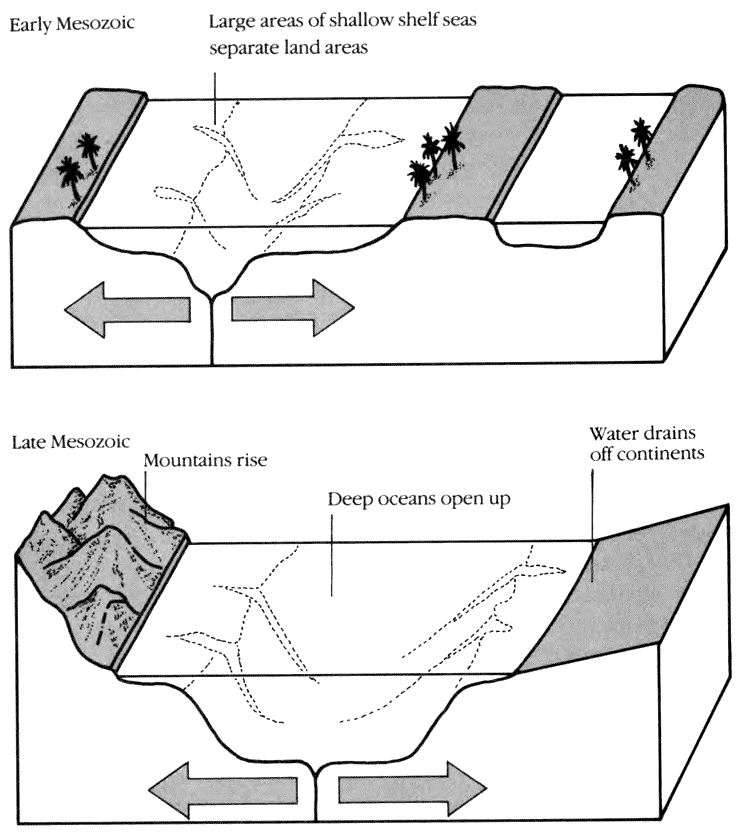
The influence of continental drift
During the early Mesozoic, the continents were close to one another and much
of their area was covered with shallow sea. The warm surface waters supported
an abundance of animal and plant life. In the late Mesozoic, the continents
were drifting apart and deep sea areas developed between them. The shallow
shelf seas drained away into the colder deep sea, and mountains rose up.
With the loss of the surface water habitat, sea plants and animals died.
There is good evidence, too, that the extinctions on land took place at a different time from the extinctions in the oceans. Timing like this is notoriously difficult to calibrate from the geological record. One method that is used is to study past records of the Earth’s magnetic field. Every now and again the magnetic field reverses, and north becomes south and vice versa. This has an effect on the magnetic minerals that are being formed in rocks at that time. By studying the magnetism of minerals in the rocks formed on land and those formed in the sea at the end of the Cretaceous period, it seems that the extinction of the land creatures took place about half a million years after that of the sea creatures.

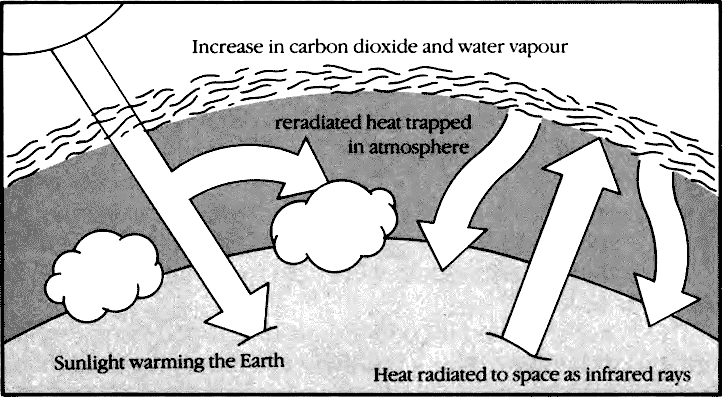
Greenhouse effect
The different proportions of gases found in the atmosphere can have a profound
effect on the climate. Normally, temperatures are kept in balance. Of the
sunlight that reaches the Earth’s surface, some is reradiated into space
as infrared rays. An increase in the proportion of atmospheric carbon dioxide
or water vapour causes much of the reradiated infrared heat to be absorbed
and trapped in the atmosphere, and hence the Earth’s surface heats up.
When all these points are taken into account, the most likely reason for
the Cretaceous extinctions would seem to be the continuing process of plate
tectonics. The surface of the Earth is continually on the move. The crust
and the outermost part of the mantle – the layer that forms the bulk of the
Earth – is continually being formed and destroyed. New material is forming
in the oceans, along the oceanic ridges, while old material is being destroyed,
swallowed up in the oceanic trenches. At the same time, the continents, trapped
in this shifting surface, are carried with the movement, colliding and breaking
apart as they go.
Through most of the Age of Reptiles the continents were all massed close
to one another. They began to move apart in the Jurassic and were well on
their way to the present positions by the time of the Cretaceous period.
This movement built up great ridges deep in the oceans, and the displaced
water spread over the edges of continents as shallow seas. The warm humid
climate produced by this geography was ideal for the large reptiles of the
time. Then, at the end of the Cretaceous, the shallow seas drained away and
the new mountain ranges, particularly the Rockies, began to grow.
The sea animals that had evolved to live in the warm shallow seas could not
survive as their warm water habitats were withdrawn and mixed with the cold
of the open ocean. Microscopic plants and animals with shells of calcium
carbonate lived in the surface waters. Their numbers now declined, which
would account for the sudden absence of calcium carbonate in the sediments
of the time. Fewer plants in the surface waters meant that there was now
less atmospheric carbon dioxide being converted to oxygen. The cooler waters
also meant that less carbon dioxide could be dissolved in the sea. There
was a resultant increase in the proportion of carbon dioxide in the atmosphere.
Carbon dioxide tends to prevent heat from escaping the Earth and a greenhouse
effect was therefore created, and the climates became much warmer. These
factors would account for the isotope ratios observed in the rock sediments
of that time.
With fewer shallow seas there was little sediment being deposited and consequently
there are no thick sequences of rock dating from this time. This would tend
to make any geological time span appear much shorter than it actually was.
Similarly, whatever iridium was being erupted from the Earth’s interior
by volcanoes at that time, particularly along the line of the new Rockies,
would
be concentrated in the few sediments that were being formed and so would
appear to be unnaturally concentrated.
On land, the continental areas would appear to be larger, because intervening
shallow seas had drained away. Land areas that had once been isolated were
now connected by dry land. For instance, animals could spread across the
breadth of North America where they had once been separated by a shallow
central sea. They could migrate across a land bridge that had now appeared
between Asia and North America. As the animals from different zones mixed
with one another they competed for the same food stocks. They also brought
with them diseases and parasites to which they were immune but their new
neighbours were not. In return, they received their neighbour’s diseases
and parasites also. The plant life was also being altered because of the
changing climates.
Altogether, it was a difficult time for any creature. If a meteorite or a
comet had happened to collide with the Earth at this time it would have administered
the final blow to an already tottering system.
Alternatively...
For the purposes of this book none of that happened. The meteorite missed.
The comet swarm passed by. The sea plants were able to adapt to the changing
water temperatures. The land animals were able to resist the diseases
and parasites of their neighbours.
In short, the animal life that had developed throughout the 150 million
years of the Mesozoic era continued to evolve for at least another 65
million years
without a break. And that is the basis for our book.
However, before we look at the creatures that exist in our alternative
zoology of modern times, we must first look at what kind of animal the
dinosaur was,
and how it evolved and developed during its heyday, in the distant times
of the Mesozoic era.
EVOLUTION OF THE LAND-LIVING REPTILES
According to the textbook, a dinosaur is denned as any member of the orders
Saurischia and Ornithischia, two of the five orders within the reptile
superorder Archosauria.
A more approachable description would be that a dinosaur is any one of
the, usually large, land-living reptiles that were so abundant during the
Mesozoic
era; that era of geological time encompassing the Triassic, Jurassic and
Cretaceous periods, between 284 and 65 million years ago. Emphasis is placed
on the ‘land-living’ part of the description. The sea reptiles of the time
– the long-necked plesiosaurs, the whale-like pliosaurs, the dolphin-like
ichthyosaurs, the sea-lizard mosasaurs, and all the turtles – were
not dinosaurs. Nor were the flying reptiles – the pterosaurs – nor the freshwater
swimmers,
the crocodiles – although these represent two closely related orders within
the Archosauria. The Mesozoic era was, indeed, the Age of Reptiles.
The archosaurs (members of the superorder Archosauria) evolved in the late
Permian period. It was a time when mammal-like reptiles were the main land-living
animals. The mammal-like reptiles were a completely different reptile group
from the archosaurs, developing from small lizard-type animals and evolving
into hairy dog-like creatures by Triassic times. At the end of that period
they died out, leaving their tiny descendants, the mammals.
During the time that the mammal-like reptiles were the most abundant of
the land-living animals, the archosaurs that had similarly evolved from
small
lizard-like creatures, were not significant. The first order of archosaur
to evolve was the Thecodontia (see pages 12—15). These were rather crocodile-like
creatures and many pursued a crocodile existence in streams and rivers.
It was not until the mammal-like reptiles died out that the archosaurs
were
able to expand and develop into four orders.
The water-dwelling thecodontians developed strong swimming hind legs and
a long paddling tail. When the land-living forms evolved they were able
to walk on the strong hind legs with the body balanced by the long tail.
They
continued to be meat-eaters. These constituted the second archosaur order
– the Saurischia or the lizard-hipped dinosaurs. The saurischians were
not all two-footed meat-eaters and some became plant-eaters. As plant-eating
requires a greater volume of gut than does meat-eating, the body of these
animals became larger and they could no longer balance on their hind legs.
These saurischians took up a four-footed pose and developed long necks.
Another group evolved from the thecodontians were able to walk on hind
legs. These were plant-eaters, but they could retain their two-footed balance
because
of the arrangement of their hip bones. The voluminous intestine could be
held beneath the hips rather than in front of them. These were the Ornithischia
– the bird-hipped dinosaurs. As time went on many ornithischians also relinquished
the two-footed pose and adopted the four-footed pose. These tended to develop
all kinds of spectacular armour as well.
Meanwhile another group of descendants from the thecodontians had adapted
to live in the skies. They began as gliders but soon developed into very
sophisticated flying creatures, with wings that could flap, a small rigid
body, slender hollow bones and a complex nervous system. These were members
of the order Pterosauria.
A final group of archosaurs remained very conservative, pursuing the same
river-wallowing, fish-eating existence of their thecodontian ancestors.
Their shape changed little. These became the Crocodylia, the only archosaur
group
to have survived the late Cretaceous extinction (according to conventional
palaeontology).
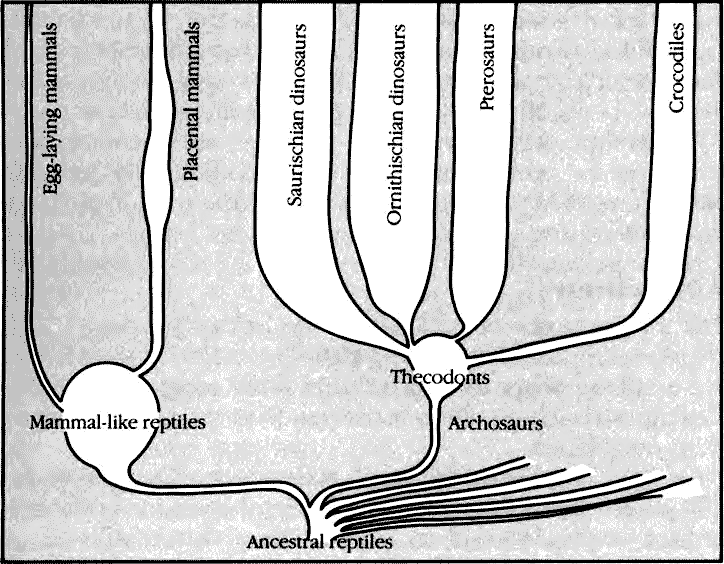
Dinosaur evolution
Many different reptile groups evolved in the late Palaeozoic era. The first
to be successful were the mammal-like reptiles. Once these had died out,
except for the line that produced the mammals, the archosaurs expanded
and became the most important group.
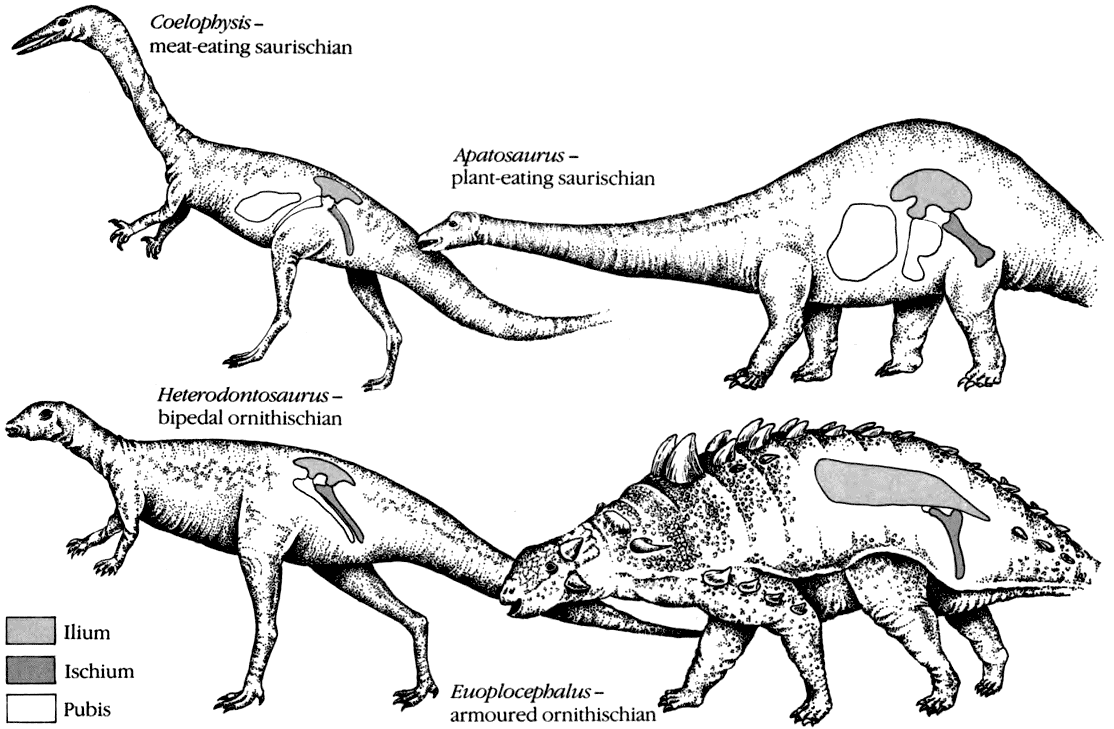
Dinosaur classification
Dinosaurs are classified on their hip types. The saurischians were the lizard-hipped
dinosaurs, so-called because the arrangement of the bones of the hip, with
the ilium attached to the backbone, the pubis pointing forward and the
ischium pointing back, was similar to that of a lizard. Meat-eating saurischians
walked on two legs. Heavy-bellied plant-eating saurischians walked on four.
The ornithischians were the bird-hipped dinosaurs, with the pubis swept
back against the ischium, like that of a bird. The ornithischians were
all plant-eaters with the pot-belly slung beneath the hips. Many armoured
forms had a greatly expanded ilium to support the weight of the armour.
The dinosaurs ruled the Earth for 170 million years, they dominated all
other forms of life, and they were the most successful group of creatures
that
ever lived. What made them so overpowering, so dominant, so successful?
Basically they were a very vigorous and constantly evolving group. As conditions
changed
throughout the Mesozoic era, they changed to accommodate them. Where there
were deserts, there were desert-living dinosaurs. Where there were swamps,
there were swamp-living dinosaurs. Forests produced forest-living dinosaurs.
It is likely that there were mountain-living dinosaurs as well, although
this is difficult to determine since mountain animals are rarely fossilized.
There is a strong possibility that many dinosaurs were endothermic; they
had the metabolism that could allow them to regulate their body heat
irrespective of the external environment. This is the condition that is commonly
termed
‘warm-blooded’ and is found in the mammals and the birds. It produces a
very high efficiency in an animal, and although a warm-blooded animal needs
more
food, this food can be more quickly converted into energy which can be
used for longer periods. The swift, active, meat-eating saurischian dinosaurs
were very probably warm-blooded, since only a warm-blooded animal could
be
alert and active enough to pursue the life style of these creatures. Most
warm-blooded animals are covered in fur or feathers to ensure adequate
heat regulation. The pterosaurs, the dinosaurs’ winged relatives, were
definitely
warm-blooded and are known to have had fur. It is possible that warm-blooded
dinosaurs may have had fur or down as well. It is difficult to say, however,
whether the large plant-eating dinosaurs were warmblooded. The argument
against this is that the shape of the head and neck would have made it
impossible
for a long-necked plant-eater to consume enough food to sustain its body
in a warm-blooded life style. The huge bulk of the body would probably
have remained at a fairly constant temperature anyway without any complex
warm-blooded
system. However, sections cut through fossils of the bones of large plant-eating
dinosaurs seem to suggest that they were fast-growing animals - and this
characteristic is only found among warm-blooded creatures.
Structurally, the dinosaurs were very soundly built. Other reptiles have
legs that appear to stick out at the side, with their bodies slung between.
This is efficient enough for a small animal like a lizard, but not sufficient
for supporting the bulk of a dinosaur. The dinosaurs evolved an upright
stance, like that of a modern mammal. In other words, the legs were held
vertically
beneath the body, so that the weight of the body was carried at the top
of the legs.
The skeletons of the largest dinosaurs were masterpieces of natural engineering.
The legs were massive, to support the great weight, but the backbones were
made of lightweight hollow struts, arranged so that maximum strength was
provided by minimum bulk.
In our alternative zoology the Great Extinction did not happen. All these
traits have therefore continued. The dinosaurs have evolved and adapted
to the Earth’s changing conditions. The dinosaurs, and the other great
reptiles
in the air and in the sea, are still the most successful and widespread
animals on the Earth’s surface. Now, before we explore the world of great
reptiles
as it is today, let us look at the history of animal life since the end
of the Cretaceous period 65 million years ago. Let us explore the evolutionary
development of the giant reptiles during the subsequent Tertiary and Quaternary
periods.
CONTENTS
FOREWORD
THE GREAT EXTINCTION 6
WHAT IS A DINOSAUR? 10
THE NEW TREE OF LIFE 12
PALAEOGEOGRAPHY 16
ZOOGEOGRAPHY 18
THE HABITATS 20
THE NEW DINOSAURS 29
THE ETHIOPIAN REALM 30
THE PALAEARCTIC REALM 42
THE NEARCTIC REALM 54
THE NEOTROPICAL REALM 66
THE ORIENTAL REALM 78
THE AUSTRALASIAN REALM 88
THE OCEANS 100
CONCLUSION 108
AFTERWORD 109
GLOSSARY 113
FURTHER READING 115
INDEX 116
ACKNOWLEDGEMENTS 120
